Are your potato plant leaves curling, leaving you confused and worried? Worry not! We’ll put your concerns to rest. It is one of the most common issues for potato growers. Finding out the core problem is the first step in solving it.
So, let’s dive into the main causes behind potato plant leaves curling, providing you with a comprehensive understanding of the potato viruses. We’ll also explore the growing needs of the potato plant. Let’s get started!
Contents
What Causes Potato Leaves Curling Disease?
There are several reasons for your potato leaf curls. Here’s what you need to know:
1. Potato Curly Pinnacle Virus
It is a viral disease affecting potato plants. Potato Curly Pinnacle Virus (PCPV) belongs to the genus Enamovirus and is transmitted by the peach-potato, resulting in significant yield losses and reducing potato crop quality. Let’s dive deep into it:
- Symptoms: PCPV-infected plants show entire leaf curling, yellowing, or chlorosis of the potato leaves.
- Transmission: It spreads through peach-potato aphids.
- Effect on Yield: Potato plants infected with PCPV have reduced tuber size and weight. Moreover, the quality of the tubers is also affected, resulting in internal necrosis and an irregular shape.
- Management: Control measures for PCPV focus on integrated pest management (IPM), using virus-free seed potatoes, and monitoring aphid populations.
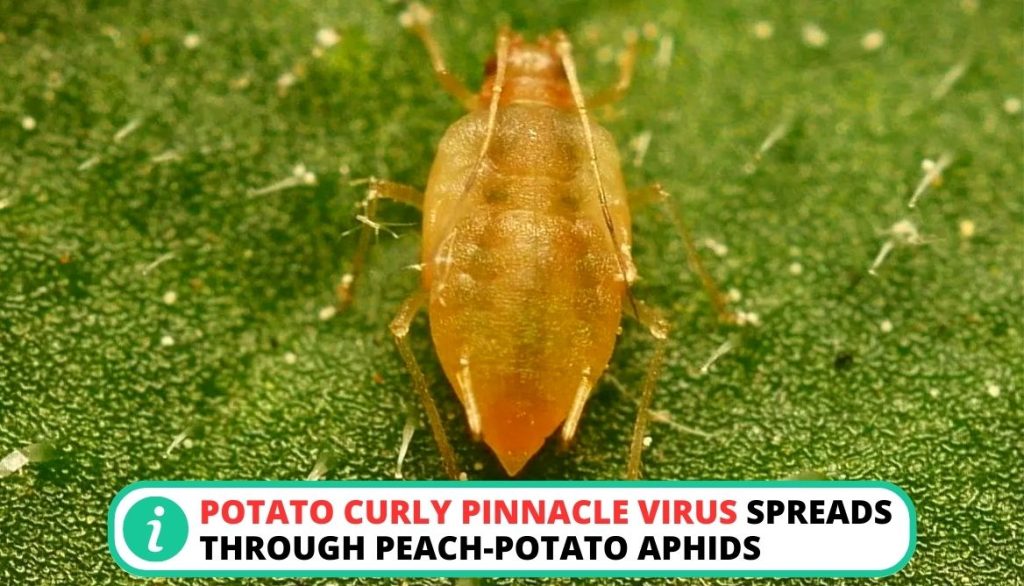
As a potato grower, you must stay vigilant against the disease. By focusing on continuous learning and early detection you can combat PCPV beyond immediate management measures.
2. Potato Virus Y
It is one of the viral diseases that affect potato plants worldwide. Potato Virus Y (PVY) is one of the most economically significant potato viruses belonging to the genus Potyvirus. Here are some facts about it:
- Symptoms: PVY infection can cause different symptoms depending on the potato cultivar and strain of the virus. Common symptoms include mosaic patterns on the leaves, leaf curling, and stunted plant growth.
- Transmission: It spreads through aphids, infected potato seeds, mechanical transmission via contaminated tools, and grafting infected potato plants.
- Effect on Yield: It significantly reduces potato plant yields, affects aerial tubers development and brown spots, and reduces storage life.
- Management: You can use Integrated pest management strategies and strict aphid control through insecticides and biological control.
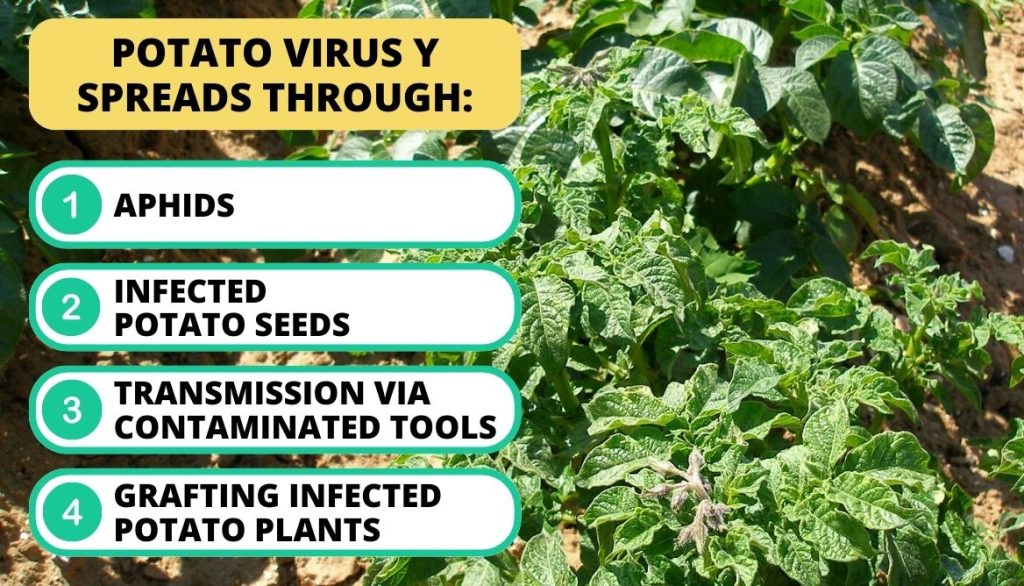
PVY is a crucial potato virus. Therefore, it requires regular monitoring. So, to combat it, you need proper sanitation like weed control, crop rotation and field isolation.
3. Potato Leafroll Virus
Potato leaf roll virus is a deadly disease that disrupts the movement of nutrients within the plants. The disease is named after the leaf-curling characteristic of the potato crop. Let’s explore it:
- Symptoms: It includes curling and rolling on leaves, yellow or pale green discoloration, stunted growth, and reduced vigor.
- Transmission: Potato leafroll virus spreads through aphids, particularly green peach aphids, and infected potato seeds.
- Effect on Yield: The disease affects potato plant yield and quality. It usually affects the phloem tissues, disturbing the transport of nutrients.
- Management: This includes controlling aphid populations, removing and destroying infected plants, and implementing potato crop rotation to break the potato virus cycle.
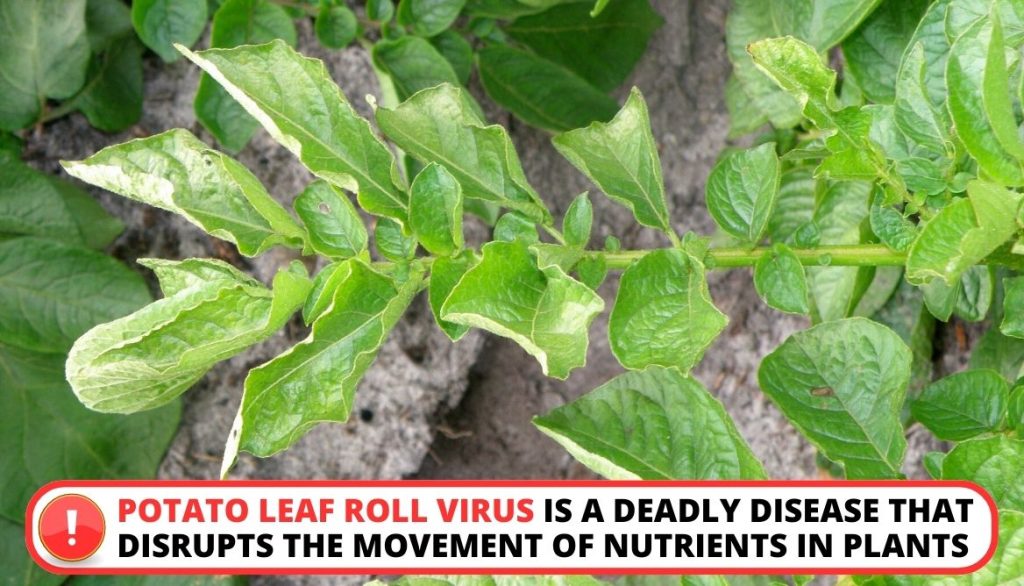
When dealing with the potato leafroll virus, remember that it can be spread over long distances. Therefore, using licensed seed potatoes is your best bet.
4. Potato Leafhopper
Potato leafhoppers are small, green insect that migrates to potato crops during the growing season. It inserts its needle-like mouthparts into the plant’s leaves and stems. Potato leafhopper feeds on the plant’s sap, particularly the beet plant, also known as “beet leafhopper,” causing damage and affecting overall plant health.
Let’s take a closer look at it:
- Symptoms: Potato Leafhopper feeding shows a characteristic “hopper burn” pattern, yellowing, and browning along the leaf margins.
- Transmission: It can transmit pathogens such as the Phytoplasma Bacteria, causing diseases like Purple Top and Aster Yellows.
- Effect on Yield: The affected crops from potato leafhopper result in stunted growth and commercial potato production.
- Management: It includes regular scouting and monitoring to detect potato leafhopper and their damage, using insecticides. You need to regularly check for them as they grow rapidly.
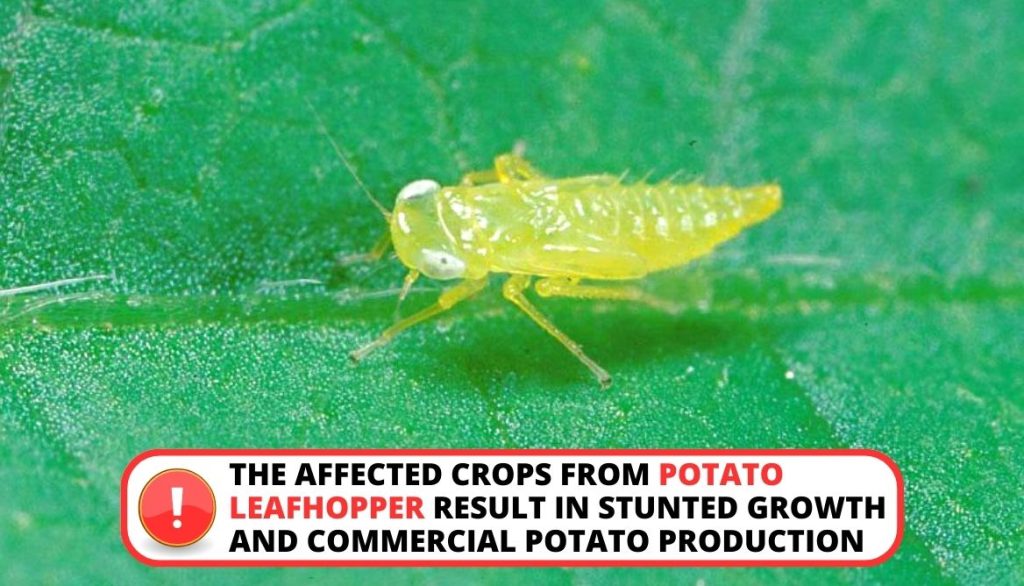
Potato leafhoppers have multiple generations in a year and migrate from host plants to potato fields. They are more prevalent in warmer regions.
5. Herbicides
Herbicides are chemical substances used to control or eliminate unwanted plants, commonly referred to as weeds. They are essential in modern agriculture, landscaping, and weed management. Continue reading to learn more about it!
- Types of Herbicides: These include selective herbicides, which target specific plants, and non-selective herbicides, which kill or damage all vegetation that comes into contact with them.
- Mode of Action: They work through various mechanisms, such as interfering with photosynthesis, inhibiting protein synthesis, and disrupting cell division.
- Environmental Impact: They cause certain problems if not used responsibly. Runoff from treated areas can contaminate water bodies and may persist in the soil, resulting in potato plant leaves curling.
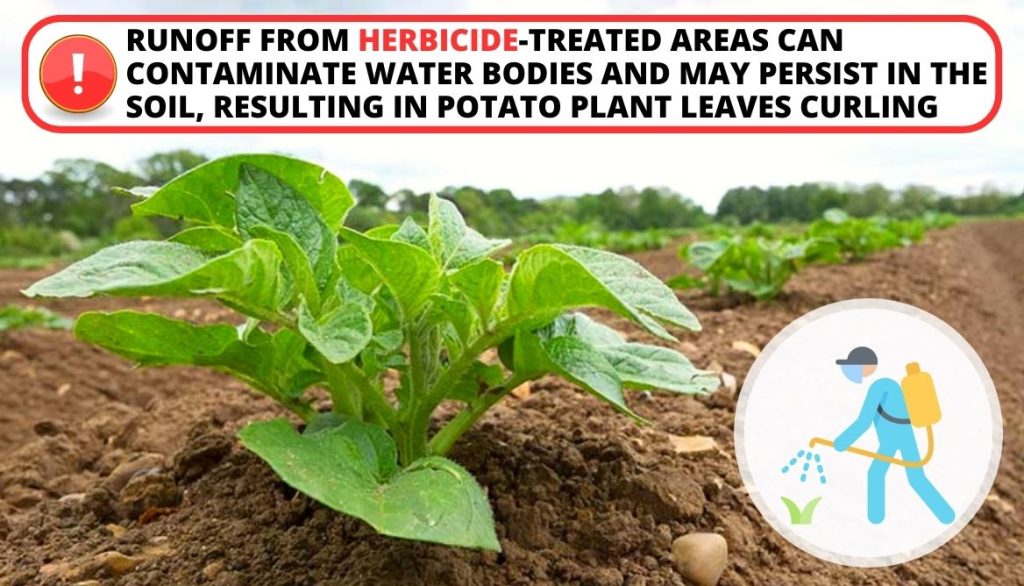
6. Improper Watering of the Potato Plant Life
Improper watering refers to practices that deviate from the plant’s specific water requirements, either by too little or overwatering. Both can lead to stress and nutrient deficiencies. Here’s an overview of the consequences of not watering correctly:
- Overwatering: Providing excessive water to plants can lead to waterlogged soil, which limits oxygen availability to the roots. Over time, this can cause root rot, nutrient leaching, and the growth of fungal diseases.
- Underwatering: Insufficient water supply can result in drought stress and negatively impact plant growth. Inadequate water affects the plant’s ability to uptake nutrients, reduces turgidity, and can lead to leaf wilting and browning.
- Watering frequency: It depends on plant species, growth stage, weather conditions, and soil type. Aim to provide about 1-2 inches of water per week through rainfall or irrigation. Then, regularly check it by inserting a fingertip up to the second knuckle. If it feels dry, it’s time to water.
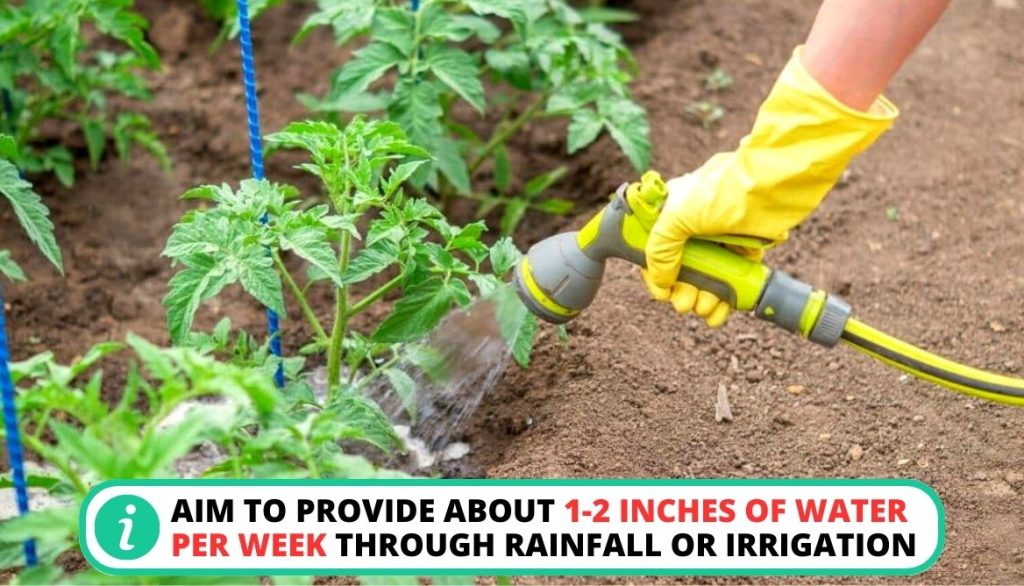
Controlling Leaves Curling Viruses in Potato Plants
Here are some steps you can take to manage virus infections in potatoes:
- Plant-Certified Disease-Free Seed Potatoes: Start with high-quality, certified potato seeds that are known to be free from viral infections.
- Remove Infected Plants: As soon as you notice signs of virus infection, such as leaf curling, yellowing, or mottling, remove and destroy the infected plants to prevent the spread of the virus.
- Control Insect Vectors: Many plant viruses, including those affecting potatoes, are transmitted by insect vectors such as aphids. Implement measures to control aphids and other potential carriers, such as using insecticidal sprays or employing beneficial insects that prey on aphids.
It’s important to note that the specific methods for controlling viruses in potato plants can vary depending on the type of virus and the specific conditions in your area.
To know more about it, you can watch this helpful video:
7 Growing Needs for Healthy Potato Plants
After knowing the main causes of potato plant leaves curling, now it’s time to get insights into the growing needs. So, let’s dive into it:
1. Planting the Certified Seed Potatoes
Planting certified seed potatoes involves using high-quality potato tubers inspected and certified for disease-free status. Here’s how you can plant them:
- You can start by selecting firm potato seeds with well-developed “eyes” or sprouts.
- Cut larger potato seeds into smaller pieces containing one or two healthy potato plants sprout.
- Allow the cut potatoes to dry and form a protective layer or callus, usually taking a day or two.
- Maintain adequate spacing between potato plants to allow for proper growth and prevent overcrowding.
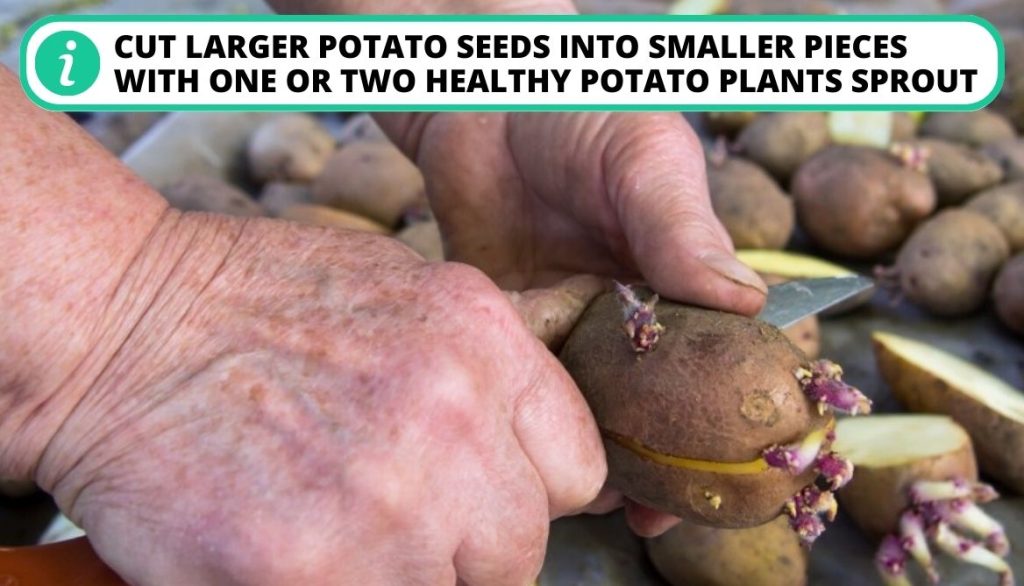
2. Pre-sprouting the Potatoes
Pre-sprouting potatoes are also known as chitting or green sprouting. It involves the development of sprouts on potatoes before planting. Let’s see it in detail:
- Place the potatoes in a cool, dry, and well-lit location, such as a windowsill or greenhouse, a few weeks before planting potatoes.
- Arrange the potatoes in a single layer, ensuring good air circulation between them.
- Allow the potatoes to develop sprouts or “chits” about 1-2 inches long.
- When the sprouts are well-developed, it is time to plant the pre-sprouted potatoes in the garden or containers.
3. Grow in Full Sun
Growing potato plants in full sun provides them with direct sunlight for most of the day (6-8 hours). Here’s how you can do that:
- Choose a location for your plants that receives ample sunlight, preferably with minimal shading from buildings, trees, or other structures.
- Monitor your plants for signs of stress or sunburn, such as wilting, yellow leaves, or scorching, and provide appropriate shade or adjust watering as needed.
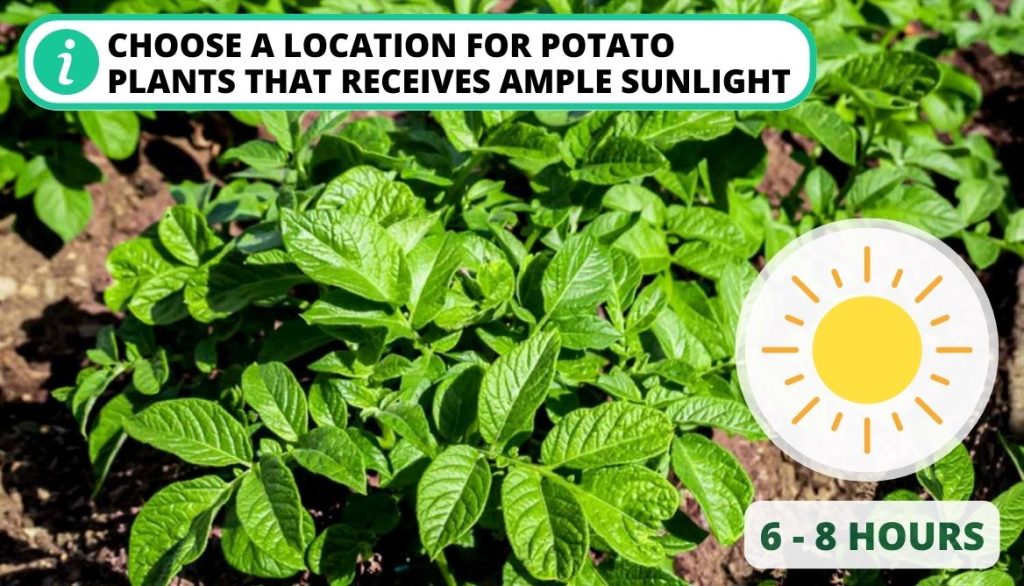
4. Plant Potatoes in Early Spring
Planting potatoes in early spring allows them to take advantage of the favorable growing conditions and longer days of sunlight. Let’s explore what it holds:
- Start planting when the soil thaws and is workable, usually when the ground temperature reaches around 45 to 50°F.
- Select certified disease-free potato seeds for best results.
- Prepare the planting area by loosening the soil and incorporating organic matter to improve drainage and nutrient availability.
- Dig trenches or furrows about 4 to 6 inches (10 to 15 cm) deep, leaving enough space between rows for easy access and growth.
- Cover the potatoes with a few inches of soil, gently firming them.
5. Water Consistently
Consistent watering is crucial for potato plant health, as water is essential for various physiological processes and nutrient uptake. Let’s learn more about it:
- Monitor the soil’s moisture level regularly, checking if the top few inches are dry before watering.
- Water plants deeply and thoroughly, ensuring that it penetrates the root zone.
- Avoid shallow watering that only wets the surface, as it encourages shallow root growth and makes plants more susceptible to drought stress.
- Use techniques like drip irrigation or soaker hoses that deliver water directly to the root zone.
- Take note of overwatering or underwatering signs, such as wilting or yellowing leaves.
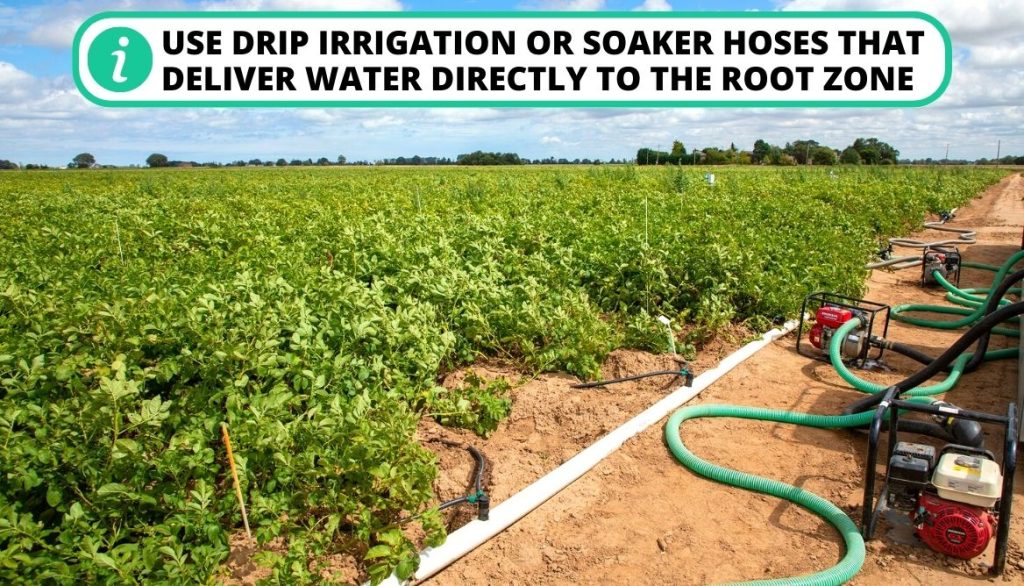
6. Keep the Tubers Covered
It is important to keep the tubers covered with soil to protect them from exposure to sunlight. Continue reading to learn more:
- Monitor the development of tubers beneath the soil surface.
- Regularly check for any exposed tubers and cover them with a layer of soil to prevent greening or sunburn.
- Ensure the soil cover is reasonable, as it can hinder the plants’ access to oxygen and restrict growth.
- Use a hand or garden tool to add soil around the plants’ bases carefully.
7. Let the Potatoes Mature Fully for Food Storage
Avoid harvesting the potatoes too early, as immature potatoes may not store well and lack optimal flavor. Here’s what you need to know:
- Check the potato skins for firmness and thickness – mature potatoes have tougher skin, providing better storage protection.
- To determine if the potatoes are ready for harvest, gently dig into the soil near the plants and inspect a few tubers.
- Wait for the vines to die completely before harvesting, ensuring the potatoes have their maximum size.
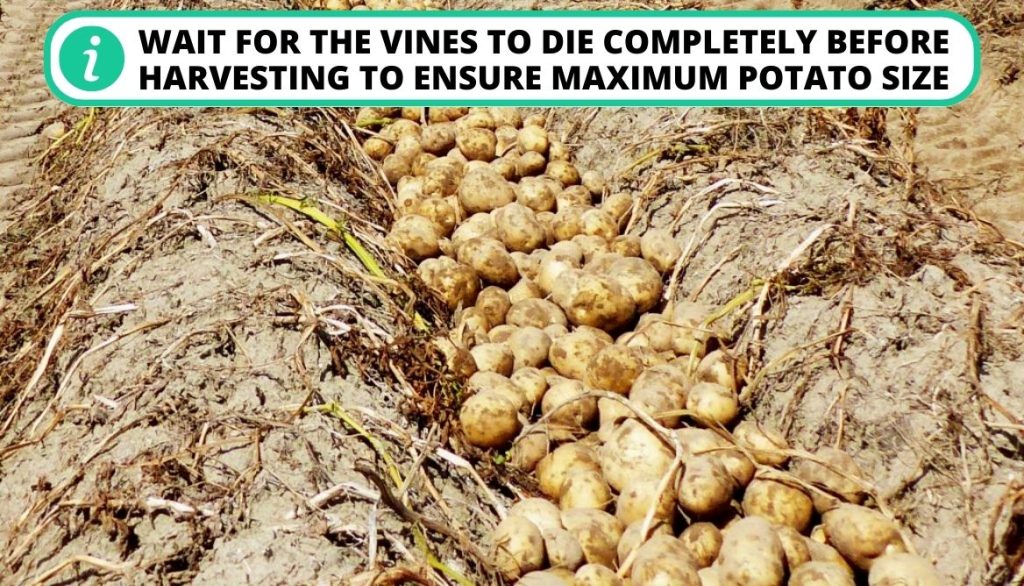
FAQ
How do you treat potato leaf curls?
To treat potato leaf curling, you can use certified disease-free potato seeds, control insect vectors, and monitor potato crops for early detection and removal of infected plants.
What are the symptoms of potato leaf curl virus?
Symptoms of potato leaf curl virus include curling and twisting of leaves, yellowing or mottling of foliage, stunted growth, and reduced yield. Infected plants may also exhibit leaf crinkling, leaf, and a general decline in health.
What do curling leaves indicate?
Curling leaves in potato plants indicates nutrient deficiencies, water stress, pest infestation, and viral infections.
What is a natural remedy for leaf curl?
Some natural remedies for leaf curling include proper watering to avoid under or overwatering, providing adequate sunlight, and improved air circulation.
Conclusion
Understanding the causes of potato leaf curling is essential for addressing the issue effectively. By identifying viruses like Potato Curly Pinnacle Virus (PCPV), Potato Virus Y (PVY), Potato Leafroll Disease, pests such as Potato Leafhopper, and factors like herbicides, you can take appropriate steps to mitigate these problems. Using insecticides, crop rotation and weed control you can save your crop easily.
Meeting the specific growing needs is also essential. Additionally, self-sown potatoes, which emerge from previously planted potatoes, can also cause curling of potato leaves. Therefore, maintaining good cultural practices is important.
So, have you ever encountered potato leaf curling? If yes, what methods have you found effective in addressing them? Let us know in the comments!
- How to Get Potatoes to Sprout Eyes: Detailed Growing Guide with 3 Options - July 31, 2023
- Weight of a Medium Potato: Revealed in Detailed Guide - July 29, 2023
- Maris Piper Potatoes: 9 Substitutes You Should Know About - July 27, 2023
Hello! I’m Jessica Zander, a garden coach and consultant based in the Boston area (zone 6b), offering virtual consultations across the country and Canada.
I’ve been passionate about gardening since the early 1990s, and in 2022, I launched You Can Do It Gardening to empower individuals to feel more confident in their gardening endeavors.
Following a 30-year career in nonprofit finance and operations, I transitioned out of that field in mid-June of 2023 due to the growing demand for coaching services. Interestingly, my years of presenting financial statements to boards and finance committees proved to be valuable experience for teaching people about gardening! I enjoy sharing skills, providing guidance and suggestions, and collaborating efficiently with clients to make significant improvements to their outdoor spaces, both small and large. I also regularly teach at the Arlington Continuing Education and Cambridge Adult Education.
My approach is direct and practical, akin to Mary Poppins, but tailored to your garden. Clients find satisfaction in saving money and taking pride in their own gardening achievements.

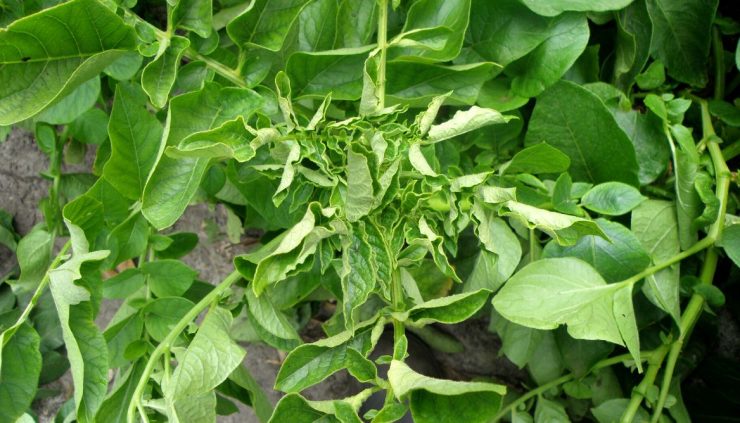
Add comment